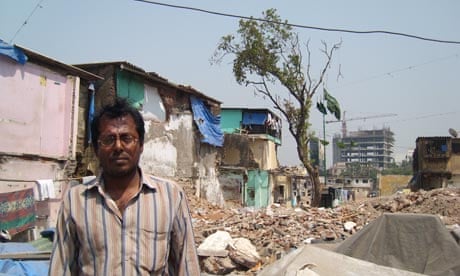Ganesh Krupa Society is part of Golibar, Mumbai's second largest slum, spanning 140 acres. The site is at the centre of a fierce battle between its residents and a developer that wants to raze the area to make way for a commercial project.
Already concrete homes across this narrow maze of more than 300 dwellings have been demolished.
In January, violence erupted when the developer tried to evict 45 families following a high court order. None of the families moved, claiming their signatures consenting to the project had been forged. Devasandhan Nair, 47, a resident, says: "The basis of redevelopment is consent but our consent was forged. Even a dead woman's signature was forged. How can the court instruct the builder to evict us when a forgery case has been lodged by us with the police?"
Conflicts between developers and slum dwellers have been unfolding across the city for more than a decade, stalling slum redevelopment projects designed to pull 60% of Mumbai's population out of harsh living conditions. Under a controversial slum rehabilitation policy, developers can snap up land for commercial development in exchange for building free houses for slum dwellers.
However, slum residents are only entitled to free housing if they have lived in the area to be cleared since before 1995, or, in some cases before 2000, which is a huge stumbling block for state government officials who say they want to make Mumbai slum free. This caveat means almost 70% of slum dwellers in the city are ineligible for a free home and would probably end up in slums elsewhere. Simpreet Singh, an activist, says high levels of migration to the city due to a lack of rural jobs combined with a shortage of affordable housing means people have no choice but to flock to the city and live in slums.
So far only 100,000 homes have been built under the scheme in the last 12 years – and 35% of those rehoused have returned to slums because maintenance costs are too steep in their new accommodation. Around 1.2m homes are needed to house the city's slum dwellers.
Against the backdrop of Mumbai's rapidly changing skyline of malls and plush high-rise apartments, the common complaint among the poor and powerless is that the government, corrupt politicians and developers are colluding to grab their land and short-change the slum dweller. Slum activist Jockin Arputham says: "This policy is about giving cakes and carrots to builders and developers. It's not in the interest of improvement of slum dwellers."
In February, the Times of India reported that the Maharashtra state government had gifted 500 acres of land to a developer under a little-known rule that waives the requirement for the 70% mandatory consent to sell from slum dwellers.
The lack of trust and transparency over land procurement has brought some of the largest development projects to a standstill, while others have simply failed to take off.
In Dharavi, Asia's largest slum, which is located on prime land overlooking the city's new business district, residents are demanding larger homes and a guarantee of their livelihoods. With 80% of people self-employed in the slum's core businesses in leather, recycling, garments and pottery, residents say they will not agree to any development plan unless they are allotted the same amount of workspace they currently occupy.
A short distance away, the Mumbai's international airport is in the midst of the city's largest slum clearance. The airport is right next to scores of slums that need to be moved for security reasons as well as for the airport's expansion. About 88,000 families need to be moved, but the scheme has met stiff opposition from residents who are ineligible for rehousing – while those who are entitled don't want to be rehoused away from their community, schools and jobs.
Mumbai's policy on slum clearance puts it at odds with the central government, which wants to see a slum-free India. The government says slum dwellers should be given property rights. If they have property rights, they can access loans to improve their slum home so that over a period of time they will no longer be slums.
This would act as an incentive for residents to invest in their homes. Furthermore, if residents get property rights, developers can't evict them. At the moment, developers are buying the rights to the property from the landowner – so they can evict tenants and demolish the slums.
Maharashtra's new chief minister recently agreed with the central government that slum dwellers should be given property rights so they are encouraged to invest in their homes. And there are murmurs of a change in state policy.
"There is a complete mismatch between the state and central government policy," says Chandrashekhar Prabhu, a former chairman of the state's housing authority. "While the state wants to give free houses through the builder, the centre wants to empower people, give them tenure, which should be the essence of slum rehabilitation."
It's too early to tell if all this will translate into action, but until state policies are drastically remoulded and slanted towards slum dwellers rather than developers, a slum free Mumbai will remain no more than a government slogan.

Comments (…)
Sign in or create your Guardian account to join the discussion